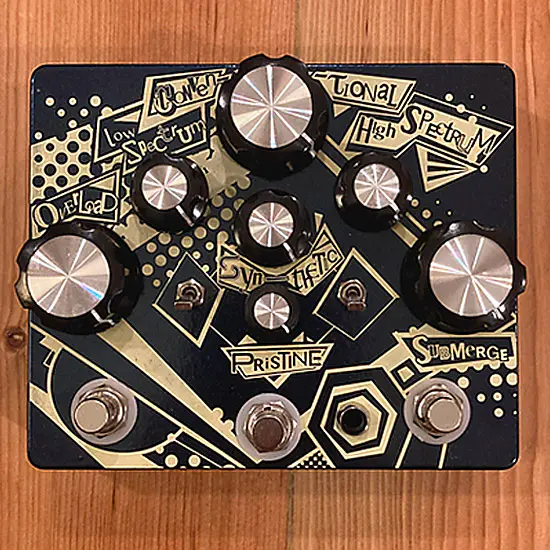
Just like most other devices released by the North Carolina’s builder, the Hungry Robot The Collective is a pedal for the creative/tinkerer guitarist, but unlike the other pedals currently in the company’s roster, this one is a fuzz – or rather, three fuzzes in one pedal.
The man behind the circuit obviously likes to offer stompboxes (and synths) that are inspiring not only in the way they sound but also in the range of possible sounds they can deliver. Thanks to its six knobs, two toggle switches, and three footswitches, the Collective already qualifies as one of the most complex and therefore tweakable fuzzes on the market.
Without mentioning the fact that this pedal features A DOZEN internal controls!!!
The Collective’s circuit consists of three fuzz circuits, a 2-band State Variable Filter and a chaotic feedback loop.
Let’s see if we can figure out what each knob does:
- At the top of the pedal, the “Conventional” knob is a traditional sounding fuzz.
- The “Low Spectrum” and “High Spectrum” knobs are part of an active State-Variable Filter (aka, EQ).
- The “Synthetic” knob is a velcro-ey, synth-ey, gate-ey, and glitch-ey logic-based CMOS fuzz.
- The “Pristine” knob is a mix knob that lets you reintegrate your clean signal to get some definition and dynamics back.
- The “Overload” knob controls the amount of signal let back through an internal feedback loop, causing self-oscillation when the left momentary footswitch is pressed.
- The left toggle switch, when in the up position, will change the behavior of the left footswitch from momentary to latch mode.
- The “Submerge” knob is a monophonic, CMOS-based sub-octave fuzz similar to the “Synthetic” fuzz, featuring a dedicated momentary footswitch (the on the right) to add in the sub-octave with its own toggle switch that can latch the sub-octave.
If you are wondering what the 12 internal controls do, well, you may have to buy one because we can’t find that information anywhere.
But even without that info, the Hungry Robot The Collective fuzz is an impressive and imaginative box that is bound to inspire fuzz lovers and tone explorers alike. Because of this, we added it to our article about the Best Crazy, Weird, and Unusual Fuzz Pedals.
Hungry Robot The Collective, Builder’s Notes
The Collective is a brand new fuzz pedal designed by Hungry Robot. The Collective is an over-designed, complex fuzz pedal, a true desert island fuzz designed to please the most ardent fuzz connoisseur. The Collective covers a lot of ground with plenty of external controls as well as over a DOZEN internal parameters to narrow down that perfect fuzz tone. The Collective is a pedal that requires and encourages exploration. The Collective has three fuzz circuits in one box. On top of that there is a 2-band State Variable Filter and a chatotic feedback loop.
Starting at the top of the pedal, the “Conventional” knob is a traditional sounding fuzz. This is meant to balance out the more chaotic fuzz tones and provides a bread-and-butter sound when you need it. The “Low Spectrum” and “High Spectrum” knobs are part of an active State-Variable Filter, similar to the one found on The Lumen. The “Synthetic” knob is a logic based CMOS fuzz that can be described using the words, velcro-ey, synth-ey, gate-ey, and glitch-ey. The “Pristine” knob allows you to blend in your clean signal when you need a bit of pureness to balance out the crazier sounds. On the left is the “Overload” knob. This controls the amount of signal let back through an internal feedback loop. The output of the fuzz is fed back into the input causing self-oscillation and some gnarly textures. Underneath the knob is a dedicated momentary footswitch to activate the feedback loop or you can latch the feedback loop ON by flipping the toggle switch up. On the right is the “Submerge” knob. This is a monophonic sub-octave fuzz. Similar to the “Synthetic” fuzz, this is also CMOS-based, so similar gated, unstable tones. The “Submerge” also has a dedicated momentary footswitch to add in the sub-octave with its own toggle switch that can latch the sub-octave.






















